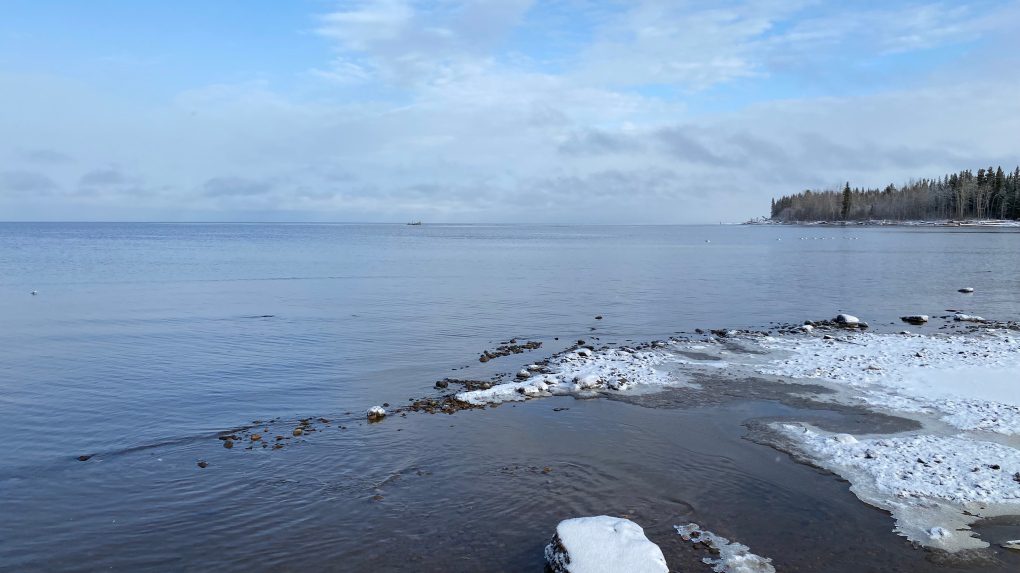Global Courant 2023-05-12 18:00:00
A number of Canadian cities have exceeded acceptable chloride levels in river basins in recent years, raising concerns about impacts on freshwater and other species.
The problem stems largely from road salt and salt solutions, which have a chemical compound of chloride to help keep roads safe during winter weather.
Chloride has both long- and short-term impacts on wildlife, and some experts believe it negatively impacts fish, frogs and aquatic ecosystems across Canada.
“In the spring, where we can have amphibians, frogs, salamanders, that get into small, shallow pools by ponds, by roads, or in the woods, they can get into salt water. That really limits their ability to survive,” Donald Jackson, a professor in the department of ecology and evolutionary biology at the University of Toronto, told CTVNews.ca in an interview.
People sometimes use the same water that we also pollute, but the The Canadian government has implemented drinking water targets to remove unnecessary toxins and salt before consumption.
Even with these goals, drinking water can be a problematic source of salt, but only for people with certain conditions.
Although the average intake of sodium from drinking water is only a small fraction of what is consumed in a normal dietintake from this source may be significant for individuals suffering from hypertension or congestive heart failure who may require a sodium-restricted diet,” said the Guidelines for Canadian Drinking Water Quality report.
For freshwater species that live in water all their lives, removing excess chloride is not an option.
The The Canadian Council of Environment Ministers (CCME) has issued guidelines for municipalities to keep rivers, streams and lakes healthy for plants and animals.
According to research from DataStream, a non-profit organization that collects information about Canadian freshwater, a number of cities across Canada had historically increased periods of chloride in their watersheds.
The CCME says that if chloride levels exceed 120 milligrams per liter (mg/L) of water, it can become a chronic problem for aquatic life. If chloride exceeds 640 mg/l, it is categorized as acute and can cause serious immediate consequences for aquatic species.
In an analysis by CTVNews.ca, data from some cities shows that chloride levels have (sometimes) exceeded 1,000 mg/L, well beyond guidelines to maintain healthy waterways.
WHERE IN CANADA IS CHLORIDE A PROBLEM?
Evidence shows that in many municipalities, the areas where roads are concentrated have chloride levels too high for freshwater species.
The data, collected between 2020 and 2023, shows cities such as Ottawa, Toronto, Calgary, Edmonton and St. John’s are seeing chloride levels in excess of 120 mg/L, enough to have an acute effect on species.
The waterways are often located within subdivisions or along main roads, where salting takes place regularly in the winter.
See the full version of the map above here.
Researchers in Nova Scotia found that urbanization without proper waterway planning harms ecosystems
that study, which will be published in the Journal of Hydrology in the June 2023 editionshows an analysis of chloride concentrations in 57 lakes around the Halifax-Dartmouth area.
Using data from the Energy and Environment Department of Halifax Regional Municipality, collected between 2006 and 2011, researchers were able to categorize which watersheds were under more pressure.
The data was collected three times a year and from there researchers averaged the chloride levels. The highest average concentration of chloride was found in Dent’s Punch Bowl, a small lake in the middle of a subdivision in Halifax.
According to the article, there was an average chloride concentration of more than 120 mg/l, which means chronic living conditions for the species in the lake.
Russell Lake in Dartmouth, NS had similar concentrations, averaging over 120 mg/L and was also in a subdivision.
Researchers were able to determine lakes along highways and major collector roads contained high average chloride concentrations.
The county recently launched a new water monitoring program to track fluctuating chloride levels in lakes, rivers and streams, among other things.
WHAT HAPPENS WHEN THE CHLORIDE CONTENT IS TOO HIGH?
Jackson says the information on which species are harmed by elevated chloride levels is minimal. The guidelines for how high the concentration can be before harming ecosystems are based on about 30 different organisms with varying resistance to chloride.
The Canadian Water Quality Guidelines for the Protection of Aquatic Lifelast updated in 2011, lists a number of fish, amphibian, plant and algae species and how long they can survive for their “end point” in high chloride concentrations.
Some species, such as rainbow trout, can withstand a concentration of 8,634 mg/L for 96 hours before dying. Other species, such as the freshwater mussel, have only 24 hours to survive at a chloride concentration of 709 mg/L.
Other species seriously affected by rising chloride levels include the rifleshell mussel (considered endangered by the federal government), the chorus frog, the spotted salamander and the fingernail shells.
For any species to survive, Jackson says, it’s about maintaining a careful balance.
If a scientist put a freshwater fish in distilled water, it would die, Jackson says, because it lacks the “ions and chloride” that help it maintain the balance of water inside and outside its body.
“If you put that fish in salt water, it would die too, because it can’t properly balance those ions in the bloodstream and outside the bloodstream,” he said.
“IF YOU… WE’LL KILL IT”
Despite the dangers, there is hope that ecosystems and species have proved resilient.
Over time, Jackson says, these organisms have learned to adapt to the increased chloride concentration.
But as levels rise at a rapid rate, it becomes more difficult for the organisms to reproduce.
“As we start to increase those (chloride compounds), we’re actually making it more difficult for the organism that is fish or the plants to maintain that balance,” he said. “And in the end we will overwhelm it and we will kill it.”
Although relatively invisible to the human eye, some of these species are used for food, such as mussels and fish, while others provide balance within ecosystems to keep other species in check.
The main problem with chloride is that once it enters the waterway it cannot be easily removed. Instead of seeing what Jackson calls a “die off,” these species will disappear.
“If it goes on for a long time, we often don’t even recognize that (they are disappearing),” he said.
WHAT CAN BE DONE?
There are some cities across Canada that showed lower levels of chloride in their waterways. Despite being on an island in the Atlantic Ocean, Charlottetown was one of the municipalities that restricted salt.
A spokesperson for the city told CTVNews.ca it has taken steps to limit salt use in the winter.
“For example, sidewalks are not salted when snow can be scraped to reveal mostly bare sidewalks, sunny weather conditions and rising temperatures are predicted after the snow is plowed, another weather event is expected in the next 24-36 hours or temperatures are too low to salt to be effective,” said the spokesperson.
Some municipalities use more sand or fine gravel to ensure chloride-free traction.
The city of Winnipeg has been using beet juice to reduce the amount of salt used on the roadway since 2020, and according to a city spokesman, it can improve the “adhesion of sand and salt to the road surface in colder temperatures.”
“Beet juice can make up to 60 percent of the solution we apply to the roads and is combined with a traditional sodium chloride based brine. This reduces our chloride load on infrastructure and the environment, while producing a good quality melting solution that is effective to temperatures below -30 C,” the spokesperson wrote in an email to CTVNews.ca.
In the northern parts of the country, chloride is not often used in winter because it does not work in temperatures of -10 C.
Data from Great Slave Lake near the Northwest Territories shows that chloride levels hovered around 10 mg/L in 2021. As of 2014, DataStream’s information shows: the chloride level around the lake does not exceed 84.9 mg/l.








